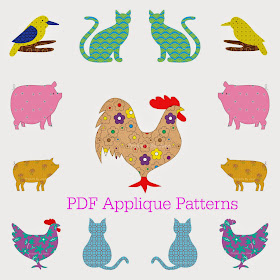What you need
An open toe foot (if you are sewing through several layers, you can also use a walking foot)
(Note that on my machine, my default setting is needle down - this means when the machine stops sewing, the needle position is always down. You want the needle to be down when you pivot which we will cover later.)
Foot Pressure
If your sewing machine has adjustable foot pressure, try adjusting to the number meant for applique. On my machine, I have 1 or extra fine fabric, 2 for applique cut work, drawn work and basting while 3 is for regular sewing.
What kind of thread do I use?
For my top thread, I have used a thicker thread, embroidery thread and regular sewing thread. I prefer to use black or something that pops. If you prefer to let your thread blend in, then match it to the colour of your applique instead of the background.
For my bobbin, I use average weight bobbin thread which is what I use for sewing clothes or bags. It's okay to use a finer thread for bobbin but don't use thick thread because it would cause a lot of tension issues.
What kind of needle do I use?
When I use thicker top thread, I use embroidery machine needle and it only comes in size 75/11 and 90/14. I find 75/11 is good for up to medium weight fabric. For thicker fabric, I would use 90/14. I have never used Topstitch needle but I've read that they work for thicker thread as well.
When I use average weight top thread, I use 80/12 sharp needle.
Tension setting: I use Auto. Refer to your sewing machine manual if you need to adjust tension setting.
Is stabilizer necessary?
I don't use stabilizer because my stitches go through the applique as well as the background fabric. That's 2 layers of fabric. But if my stitches were to go through the background fabric only, then I'll need stabilizer.
If you are sewing through several layers (like a quilt), a stabilizer might not be necessary. You need to try it out and see.
What stitch length do I use?
This is not absolutely necessary but I find that I much prefer using a slightly shorter stitch length. My Janome default stitch length is 2.2. I go down to 2.0. However when I use Aurifil 40wt thread, I like my stitch length to go up to 3.0. Stitch length is definitely a personal preference.
Beginnings and ends of threads
You could back stitch the beginnings and ends of your stitching. For me, I prefer to do it manually. I leave a tail in the beginning and keep it out of the way. When I end, I leave a tail as well. From the back, you should be able to pull 2 threads to the back. From the front, you should have 2 tails left. Use a needle to bring the threads to the back. Tie off (twice to be secure) and cut off the tails.
Sewing
Sew about 1/8" away from the edge of the applique. You just have to eyeball it. If you need a guide, you can use a heat erasable pen to draw an outline on the applique and follow it.
Pivot
When you pivot, what you actually do is this. Have needle down in the applique when you stop sewing. If your sewing machine doesn't have a needle down function, you need to manually rotate it to be down. Lift presser foot. Rotate the applique to whatever position you want.
Every time the sewing needle takes a forward stitch, it does it in a straight line. As long as your applique has a straight line, you won't need to pivot. But you will come to corners, curves, sharp points and these are areas where you need to pivot. The principle of pivot is very simple. Try to imagine the straight line the sewing needle will make. The edge of the applique needs to be parallel to that straight line. Visualise the next stitch on your applique. Will your needle hit the applique right where it should? If not, your applique is not aligned with the needle and you need to rotate the applique so that it will.
Above you can see I have reached the tip of the heart and if I keep sewing, I will go outside the applique.
Here I have rotated the applique to the right such that my next stitch will be parallel to the corresponding edge of the applique.
Sometimes it's not so obvious you need to pivot especially for curves. Above, can you visualise that if I continue sewing, the sewing line won't be parallel to the edge of the applique?
My pivot is very small. I rotated the applique just a little to the right. But now I feel more confident my next stitch will lie exactly where I visualised it.
Above I have not done any pivot and I can already see my stitches are too close to the edge. I'm going to show you what happens if I don't pivot and let the machine keep sewing.
The sewing machine sews in a straight line. It is programmed that way.
Below I have captured a few steps in sewing around a rabbit applique.
For an applique like a rabbit, it has many tight corners like the ears and feet. You might have to pivot for every single stitch.
Straight stitch applique is also perfect for felt!
*****
Bag Patterns at my Etsy shop
Applique patterns at my Etsy shop
For more Applique Resources
For more Tutorials











GREAT tutorial Jane! Thanks!!
ReplyDeleteWhat a great tutorial. You explained it so well!
ReplyDeleteGreat tutorial on straight stitch applique! You've given me confidence to tackle a project I've been afraid to start. Thank you.
ReplyDelete